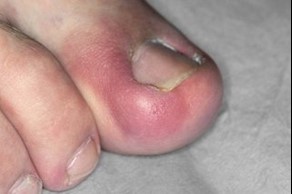What is an ingrown toenail?
An ingrown toenail occurs when the edge of the toenail grows into the surrounding skin, causing pain, swelling, and sometimes infection. It most commonly affects the big toe, but it can occur on any toe, and can make day to day activities uncomfortable.
If untreated, an ingrown toenail can become severely painful and lead to more serious complications such as infection.

Why does this happen?
There are many reasons this can occur including:
- Improper Toenail Trimming: Cutting your nails too short or cutting into the corners of the nail can lead to ingrown toenails.
- Excessive Sweating/Moisture: The skin surrounding the toenail(s) softens and increased the risk of toenail growing into the skin.
- Tight Fitting Footwear: Shoes, socks or hosiery that is too tight can cause the toenail to grow into the surrounding skin.
- Injury: Trauma to the toe, such as stubbing or pressure from our footwear can increase the risk on an ingrown toenail.
- Nail Shape: Nails that are broad, curved or thickened can increase the risk of ingrown toenails.
How can I prevent this?
There are things you can do to prevent an ingrown toenail as part of your personal footcare routine. Further information and support available from our personal footcare site.
Important points to remember:
- Ensure you are using the appropriate equipment and technique when cutting your nails. Cut nails straight across and avoid cutting them too short. Nail files are useful for maintaining nail length and smoothing any rough edges.
- Good hygiene is essential (including hoisery). Washing and drying your feet properly can reduce risk of infection and reduce skin irritation.
- It is important that your footwear is well fitting, with enough room for your toes. Avoid shoes that press your toes together. ‘Looking after your feet’ booklet
What do I do if I have an ingrown toenail?
For mild cases of ingrown toenails, the following methods may be effective:
- Bathing In Salt Water: Warm water in a clean basin with ordinary table salt can sooth the symptoms of ingrown toenails and keep the affected toe(s) clean.
- Correct nail cutting: Trimming your nails straight across and avoiding cutting into the edges can help the condition from worsening
- Over-The-Counter Medication: Pain relief, paracetamol or ibuprofen.
- Podiatry Treatment: If the ingrown toenail does not resolve, becomes more painful, persistent or infected, Podiatry treatment is advised. Details on how to make an appointment are below.
What will happen at my initial appointment?
At your initial podiatry appointment, your safety is paramount. Therefore, we will take a history of any long term health issues or medications to make sure that any management options discussed are suitable for you.
We may be able to resolve the problem at that initial appointment, however, in some cases you may need further treatment which may require a local anaesthetic. We will discuss all your treatment options and will refer you for nail surgery if agreed and appropriate. We will discuss with you the benefits, the risks and the alternative options which will give you the opportunity to voice any concerns you have so you can make an informed choice of your management plan.
We can arrange for antibiotics if they are required. You may be supplied them by the podiatrist or have them requested by you GP.
Nail Surgery
What is nail surgery?
If we have not been successful in managing your problematic nail conservatively, then we can refer you for nail surgery.
What will happen at my nail surgery appointment?
Again, you will have the chance to ask questions and voice any concerns. We will not proceed without your consent and you are free to decline treatment on the day if you change your mind.
The procedure is performed under local anaesthetic which will numb the affected toe(s). This allows us to safely remove the full nail, or part of the nail depending on what was decided during the discussions. A chemical is then applied to the nail bed to prevent a portion or full nail from regrowth. This is a permanent solution which will reduce the chances of regrowth.
A family member/friend may accompany you to your appointment for support if needed.
Preparing for the appointment
- Ensure you have breakfast/lunch depending on the time of your appointment
- Bring open toe shoes (sandals, flip flops etc.) to accommodate the dressing that will be applied
- Ask of family member/friend to drive you or consider public transport. If this is not possible you may drive
- Ensure you are able to rest the foot following the procedure. The Local anaesthetic will wear off in approximately 2-3 hours, take care not to damage it while it is numb.
Aftercare and what to expect
We will discuss with you how best to look after your toe after your nail surgery procedure and provide written advice. You will be provided with a small supply of dressing and advised where you can source more dressings.
We will discuss expected healing times at the appointment. This can vary depending on any underlying health issues which may affect the rate of healing but could be anything up to 12 weeks.
It is important to monitor the are for sign signs and symptoms of infection -such as redness, increased swell or pain- and again, we will go through all this at the end of your appointment and allow you to ask any questions you may have
You can self-refer to NHS Greater Glasgow & Clyde podiatry by contacting NHSGGC Podiatry Referral Management Centre:
Phone: 0141 347 8909 (Monday to Friday 8.00am – 8.00pm, Saturday 9.00am – 1.00pm)
Email: AHP.Appointments@ggc.scot.nhs.uk
You will initially be given a telephone triage appointment, where you will have a consultation with one of our highly skilled podiatrists. Depending on the severity of your problem, they make any appropriate referrals or appointments as required.
